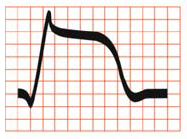Myocardial Infarction Flashcard
Rationale
D. Rationale: The posterior descending artery receives oxygenated blood from the right coronary artery and supplies the right ventricle. Therefore, a lesion in the posterior descending artery affects the right ventricle mostly in its inferior and posterior walls. Myocardial infarction in this area is very rare. ECG changes in the right ventricle can be detected by moving the leads to the right side to mirror image the left precordial leads. They are appropriately labeled as V2R, V3R, V4R, V5R, and V6R.
Answer choice A – If the lesion were higher up in the right coronary artery, V1 might have abnormal findings. However, since the lesion is in the posterior descending artery, it is more distal and affects the inferior and posterior aspects of the right ventricle.
Answer choice B – If the lesion affected the inferior wall, changes would be noted in lead II.
Answer choice C – If the lesion affected the lateral wall, changes would be noted in lead aVL.
“
Question
A patient with a coronary artery lesion in the posterior descending artery most likely has ECG abnormalities in which of the following leads?
a. V1
b. II
c. aVL
d. V4R
Answer
d. V4R
Rationale
A. Rationale: The transmural lesion is the highest grade of ischemia and may be difficult to treat because this injury encompasses all of the layers of the heart. This pattern has the most extensive ST elevation.
Answer choice B – The characteristic pattern of a subendocardial lesion is ST segment depression.
Answer choice C – The characteristic pattern in a subepicardial lesion is inverted and symmetrical T waves.
Answer choice D – Subendocardial ischemia is represented by tall or peaked T waves.
“
Question
Refer to the ECG tracing below. This pattern most likely represents which specific type of myocardial infarction?

a. Transmural lesion
b. Subendocardial lesion
c. Subepicardial lesion
d. Subendocardial ischemia
Answer
a. Transmural lesion
Rationale
B. Rationale: Prinzmetal angina presents as a transmural lesion (ST elevation) on ECG. It is a medical condition brought about by a vasospastic angina. When the vasospasm resolves, the abnormal ECG finding will revert to normal.
Answer choice A – Coronary ischemia manifests as ST depression on ECG.
Answer choice C – Myocardial infarction manifests as irreversible ST elevation on ECG.
Answer choice D – Hyperkalemia manifests as tall, peaked T waves on ECG.
Question
Which medical condition is represented by a reversible ST elevation on ECG?
a. Coronary ischemia
b. Prinzmetal angina
c. Myocardial infarction
d. Hyperkalemia
Answer
b. Prinzmetal angina